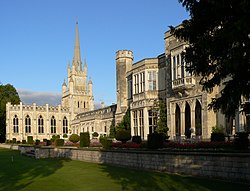Ashridge



Ashridge is an estate and house in Hertfordshire and Buckinghamshire, close to the Bedfordshire border. It lies within the Chiltern Hills, an Area of Outstanding Natural Beauty, about two miles north of Berkhamsted.
Surrounding villages include Aldbury, Pitstone, Ivinghoe, Little Gaddesden, Nettleden, Frithsden and Potten End.
The estate comprises 5,000 acres of woodlands (known as Ashridge Forest), commons and chalk downland which supports a rich variety of wildlife. It also offers a good choice of waymarked walks through outstanding country. The estate is currently owned by the National Trust.
History
Ashridge Priory
In mediæval times it was the location of Ashridge Priory, founded in 1283 by Edmund, 2nd Earl of Cornwall, a nephew of King Henry III, who had a palace here at Assherugge.
The College of Bonhommes which the Earl founded was founded was later re-endowed by Edward the Black Prince and flourished as a seat of learning and debate until the dissolution of the monasteries by Henry VIII in 1539.
The Ashridge Estate
The King took possession of the monastic estates and later bequeathed Ashridge to the infant Princess Elizabeth, who lived there for eight years with her half sister and brother. Elizabeth was arrested there by Mary in 1554.
As Queen, Elizabeth retained the Ashridge Estate. After her death, in 1603, her Lord Chancellor, Thomas Egerton, bought the estate and received from Kinhg James I an earldom, becoming the Earl of Bridgewater. The fourth Earl (called ‘Scroop’) became the first Duke of Bridgewater and his youngest son became known as the Canal Duke after developing waterways for industrial transport. His new riches from the canals funded the building of today's grand house.
In 1848 the estate passed to the Earls Brownlow, another strand of the Egerton family,[1]
In 1921 the Estate was split; the land was given to the National Trust, while the house and garden were acquired by speculators. In 1921 Urban Hanlon Broughton bought the house as a gift for the Conservative Party intended to commemorate Andrew Bonar Law and to train Conservative party workers.[2]
Ashridge House and the Egerton Family
Ashridge House is a grand building; one of the largest Gothic Revival country houses in Britain. It stands on the county boundary; most of the house is in Buckinghamshire, but the border runs through the Dining Room and the west wing and many outbuildings are in Hertfordshire.
The house was built by the 3rd Duke of Bridgwater, the "Canal Duke", from his new riches earned from the development of canals. The building was begun in 1808, designed in the Gothic revival style by architect James Wyatt. The gardens were designed by Humphry Repton. It was complete in 1825.
During the First World War the house served as a hospital, and in the Second it became an emergency wing of the Charing Cross Hospitial.
In the 1920s Urban Hanlon Broughton bought the house and gave it to a trust established by Andrew Bonar Law, the former Prime Minister. In 1929 it became a "College of Citizenship" established to help the Conservative Party develop its intellectual forces in opposition to left-wing organisations such as the Fabian Society.
The House remains in the Ashridge (Bonar Law Memorial) Trust but operates as a chairity with no political affiliation. It is home to the Ashridge Business School.
Bridgewater Monument

The Bridgewater Monument (51°48’29"N, -0°35’40"W) is a tower on the Ashridge estate, built in 1832 in memory of Francis Egerton, 3rd Duke of Bridgewater (1736–1803), "the father of inland navigation".[3] It is 108 feet tall, with 170 steps inside, designed by Sir Jeffry Wyattville in a Doric style. It overlooks the village of Aldbury and the Grand Union Canal.
The monument was built away from Ashridge House as his mother wanted "not to see or be reminded of my infernal son" [4]
Ashridge Business School
In 1959 Ashridge College was re-launched to provide management training, and is now Ashridge Business School.[5]
Use in films
Ashridge Common has been featured many times in film and television series due to its distinction as an area of natural beauty. Scenes for Sleepy Hollow, Jonathan Creek and Harry Potter and the Goblet of Fire were filmed in Ashridge's Frithsden Beeches wood.[6] The Ashridge House, which is now Ashridge Business School has been featured in films such as The Dirty Dozen.[7]
Golf Club
Part of the estate became Ashridge Golf Club in 1932, and had Henry Cotton as its club professional in the late 1930s, including his most successful year 1937.[8]
Ashridge Commons and Woods
Ashridge Commons & Woods (51°48’42"N, -0°35’14"W) is a 1,581.7 acre Biological Site of Special Scientific Interest. The site was notified in 1987 under the Wildlife and Countryside Act 1981 and lies on the Buckinghamshire and Hertfordshire border and is home to much semi-natural vegetation. As well as this, the site has extensive areas of woodland, grass and plantations. The site supports bird-breeding community which as both country and national different species of birds.[9]
Outside links
- Ashridge Estate information at the National Trust
- Ashridge Business School
- Ashridge (A Guide to Old Hertfordshire)
References
- ↑ Sanecki, K. A. pg 6
- ↑ Sanecki, K. A. pg 73
- ↑ Duke of Bridgewater Monument at Ashridge Estate Visit East of England
- ↑ Birtchnell P, A History of Berkhamsted, 1972, Clunberry Press
- ↑ Rural Heritage Society
- ↑ "Special trees and woods - Frithsden Beeches". Chilterns Conservation Board. http://www.chilternsaonb.org/caring/stwp_site_details.asp?siteID=414. Retrieved 2010-02-16.
- ↑ The Dirty Dozen at IMDb
- ↑ Ashridge Golf Club
- ↑ "Ashridge Commons and Woods". English Nature. http://www.english-nature.org.uk/citation/citation_photo/1000452.pdf. Retrieved 2008-02-24.
Books
| ("Wikimedia Commons" has material about Ashridge) |
- Coult, Douglas (1980). A Prospect of Ashridge. Chichester: Phillimore. ISBN 0-85033-360-1.
- Sanecki, Kay (1996). Ashridge - A Living History. Phillimore. ISBN 1-86077-020-7.